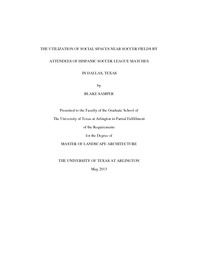| dc.description.abstract | The purpose of this research is to observe and identify the social interactions in pedestrian spaces immediately surrounding soccer fields during Hispanic soccer league matches in Dallas, Texas. The research uses passive observation of spectators at Hispanic soccer league matches in the Dallas area to determine which activities are prevalent and which types of spaces are most commonly used and for what purpose. Recent immigration has greatly boosted the numbers of Hispanics living in North Central Texas (Price & Whitworth, 2004). This population increase is leading to wide demographic changes where immigrants settle. One of these shifts is occurring in the athletic world of soccer. Soccer fields are being used by an increasingly diverse population, and this is leading to new uses for existing sports facilities (Sanchez, 2010). In Hispanic communities, soccer leagues provide more benefits to the participants than just entertainment and recreation. They create third places for people to socialize in a way that is familiar to them and part of their Hispanic culture (Price & Whitworth, 2012). Hispanic visitors to soccer facilities may use the space for their primary leisure activities. In addition to providing space for soccer matches, areas around soccer fields are used for networking, news-sharing, community outreach, and even celebrations of tradition (Price & Whitworth, 2004). Therefore, the spaces around soccer fields are more relevant to everyday life now than ever before. Despite their importance, soccer fields can be out of reach or difficult to access for many Hispanic communities (Garcia, et. al., 2002). Hispanic soccer players, especially adult males, adapt to spaces not designated for soccer or "jump the fence" to access fields without permission when fields are perceived to be inaccessible through city regulations (Sanchez, 2010). This in turn causes problems for cities trying to maintain order in their parks systems and for players who are removed from the playing fields. This issue contrasts with the cultural importance of these soccer fields to the Hispanic communities. The data for this study are gathered through observation (Taylor & Bogdan, 1998). In addition to noting the conditions and amenities surrounding soccer facilities in the Dallas-Fort Worth metropolitan area, the observations catalog the behaviors of visitors to these facilities and the spaces they use. This information is useful for sports facility designers in order to develop design guidelines for soccer facilities that better accommodate the increasing Hispanic population. The study found that the six types of spaces around soccer fields used by those observed were designated seating areas, areas near vehicles, trees, food vendor kiosks, open spaces, and slopes. These spaces facilitated seven behavioral trends that were also observed. These were clustering, lingering, sheltering, mimicking, informing, observing, and playing. This information gives insight into which spaces are used most and for which uses. The findings from the study also led to more questions which are discussed as future research topics. | en_US |


